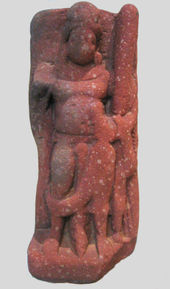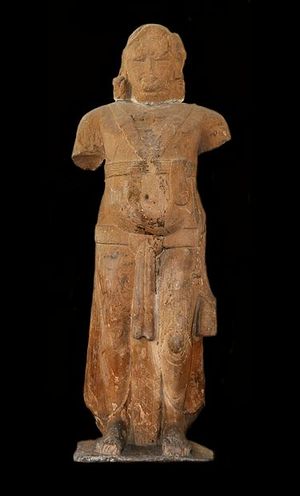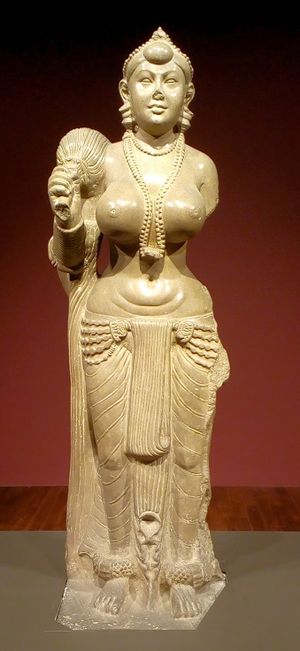
| YAKSH
Yaksh reliefs. Bharhut, 2nd century BCE
Mathura Yaksh, 1st-2nd century CE
Image of Yaksh from Parkham Mathura, 3rd-2nd century. Mathura Museum. Yaksh (Yakha, Yakkha) is the name of a broad class of nature-spirits, usually benevolent, who are caretakers of the natural treasures hidden in the earth and tree roots. They appear in Hindu mythology, Jain and Buddhist mythology. The feminine form of the word is yaksi or yakshini (Pali: yakkhi or yakkhini).
General
character :
In Kalidas's poem Meghadut, for instance, the Yaksh narrator is a romantic figure, pining with love for his missing beloved. By contrast, in the did actic Hindu dialogue of the Yaksaprasnah ("questions of the Yaksh"), a dangerous cannibalistic Yaksh, the tutelary spirit of a lake, threatens the life of the epic hero Yudhisthir.
The Yakshs may have originally been the tutelary gods of forests and villages, and were later viewed as the steward deities of the earth and the wealth buried beneath.
In Indian art, male Yakshs are portrayed either as fearsome warriors or as portly, stout and dwarf -like. Female Yaksh, known as Yakshini, are portrayed as beautiful young women with happy round faces and full breasts and hips.
In the state of Kerala, in South India, Yakshis are depicted as vampire enchantresses.
The Kirats are Limbu, Rai, Yakkha, Sunuwar and Lepch tribes of Eastern Nepal.
Yaksha
in Mahabharat :
Van Parv, Mahabharat / Book III Chapter 174 tells us Pandvs journey twelfth year of their sojourn in forests having arrived reach Saraswati River. The holy fig, the rudaraksh, the rohitak, the cane and the jujube, the catechu, the sirish, the bel and the inguda and the karira and pilu and sami trees grew on the banks of the Saraswati. Wandering about with contentment in (the vicinity of) the Saraswati which was, as it were, the home of the celestials, and the favourite (resort) of Yakshs and Gandharvs and Maharshis, those sons of kings lived there in happiness."
Yaksh
in Buddhism :
In Buddhist mythology, the Chinese language Pinyin are the attendants of Vaisravan, the Guardian of the Northern Quarter, a beneficent god who protects the righteous. The term also refers to the twelve heavenly generals who guard the Buddh of Medicine.
In
Mahavansh :
Yakshs
in Jats :
Jakhar
:
Yaksh
Kingdom :
Didarganj Yakshi :
Didarganj Yakshi The Didarganj Yakshi (or Didarganj Chauri Bearer) is sometimes considered as one of the finest examples of Mauryan art in the 3rd century BCE. Alternatively, it is rather dated to the 2nd century CE, based on the analysis of shape and ornamentation. The treatment of the forelock in particular is said to be characteristically Kushan.
The sculpture is currently located in the Bihar Museum in Bihar, India. It is 64" tall, carved out of a single piece of stone. This life-size standing image is tall, well-proportioned, free-standing sculpture is made of sandstone with well polished surface, a characteristic usually associated with Mauryan polish. The Flywhisk (chauri) is held in the right hand whereas the left hand is broken. The lower garment create a somewhat transparent effect. The Didarganj Yakshi is estimated to date from ca. 3rd century BCE to the 2nd century CE. It was excavated on the banks of the Ganges River, at the hamlet of Didarganj Kadam Rasual, northeast of the Qadam-i-Rasul Mosque in Patna City, on October 18, 1917 by the villagers and by the noted archaeologist and historian, Professor J N Samaddar[21] Professor Samaddar, with the help of the then president of Patna Museum Committee and member of Board of Revenue, Mr. E. H. C. Walsh and Dr. D. B. Spooner, the noted archaeologist, retrieved the figure in Patna Museum, Patna.
Mandarachal
:
Selection
:
History
:
Didarganj
Yakshini :
References
in Mahabharata
Pandavs
Expeditions :
Lomasa said, now hast thou left behind the mountains Usiravija, Mainak and Swet, as well as the Kala hills, O son of Kunti , O bull among the descendants of Bharat, here flow before thee the seven Gangas. This spot is pure and holy. Here Agni blazeth forth without intermission. Now wilt thou see the play-ground of the Devas , marked with their footprints, as we have passed the mountain Kala. We shall now ascend that white rock — the mountain Mandara , inhabited by the Yaksh, Manibhadra and Kuvera, king of the Yakshs. O king, at this place eighty thousand fleet Gandharvs, and four times as many Kimpurushs and Yakshs of various shapes and forms, holding various weapons, attend upon Manibhadra, king of the Yakshs. In these regions their power is very great. And in speed they are even as the wind. They can, without doubt, displace even the lord of the Devas from his seat. Protected by them, and also watched over by the Rakshashs, these mountains have been rendered inaccessible. Here are fierce ministers of Kuvera and his Rakshash kindred.
Section 3: 152 describes Pandava Bhim's expedition to this territory :
Bhim saw in the vicinity of the Kailash cliff, that beautiful lotus lake surrounded by lovely woods and guarded by the Rakshashs. And it sprang from the cascades contiguous to the abode of Kuvera. And located on the rocky elevation this expanse of excellent water was exceedingly fair. That unearthly receptacle of waters was covered with celestial Saugandhik lotuses. And this lake was the sporting region of the high-souled Kuvera, the king of the Yakshs. And it was held in high regard by the Gandharvs the Apsaras and the celestials. And it was frequented by the celestial sages and the Yakshs and the Kimpurushs and the Rakshashs and the Kinnaras; Hundreds and thousands of Rakshashs, named Krodhavas were guarding that lake, wearing uniforms and armed with various weapons.
Ashtavakra's
expeditions :
The illustrious Ashtavakra set out on his journey. He proceeded more and more towards the north and at last reached the Himavat mountains peopled by Siddhas and Charanas Arrived at the Himavat mountains, that foremost of Brahamans then came upon the sacred river Vahuda whose waters produce great merit. He rested for some more time by the side of that lake in the course of the Vahuda whose shores he had reached. Refreshed by such rest, he set out from that region and then proceeded towards Kailasa. He then beheld a gate of gold. He saw also the Mandakini and the Nalini of the high-souled Kubera, the Lord of Treasures. Beholding the Rishi arrived there, all the Rakshashs having Manibhadra for their head, who were engaged in protecting that lake abounding with beautiful lotuses, came out in a body for welcoming and honoring the illustrious traveler.
More
information on the region :
Because all the treasures of the north stretches in a line towards the east and the west, therefore is the north sometimes called the central region. Hither, is the asylum, known by the name of Vadari Badrinath . It was here, on the breast of Kailasa, that Kubera, was installed on the sovereignty of the Rakshashs, the Yakshs and the Gandharvs. It is in this region that (Kuvera's gardens called) Chitrarath lie and it is here that the asylum of (the Munis called the) Vaikhanasas is situate. It is here, that the celestial stream called Mandakini, and the mountain Mandara are to be seen. It is here that the gardens called Saugandhi-kanak are always guarded by the Rakshashs. Here are many plains covered with grassy verdure, as also the plantain forest, and those celestial trees called the Sautanakas. It is in this region that the mountains of Kailash lie, the abode of Ailavila (Kuvera). It is here that the ten Apsaras known by the name of Vidyutprabha had their origin. Here, in this quarter, at a place called Usiravija, by the side of the golden lake, king Marutta performed, a sacrifice.gold mines of Himavat exhibit themselves to the illustrious and regenerate Rishi Jimuta and hence known by the name of the Jaimuta gold. At (14:16) Pandavs were mentioned as mining this gold.
The region, called Mandakini, of king Vaisravan is attained by those highly blessed persons for whom are every joy and comfort. There Gandharvas and Yakshas and Apsaras live (13: 102).
The spot where Ganga rusheth past, cleaving the foremost of mountains which is frequented by Gandharvas and Yakshas and Rakshasas and Apsaras, and inhabited by hunters, and Kinnars, is called Gangadwar (3:90).
Delicious and cooling breezes murmuring through forests of tall Mandaras, and bearing fragrance of extensive plantations of jasmine, as also of the lotuses on the bosom of the river Alak and of the Nandan-gardens, always minister to the pleasure of the King of the Yakshs. (2,10).
On the south of Nishadh is the Varsha called Hiranmaya where is the river called Hiranwati. There, liveth that foremost of birds named Garuda . And the people there, are all followers of the Yakshs, wealthy, and of handsome features (6: 8).
Brahma-vodhya,
and Vrihadvati were mentioned as rivers of Yaksh regions (6: 9).
The lord Kuber of body resembling pure gold, seated on his car of great splendor, and accompanied by numerous Yaksh came there. And the lord of treasures, possessed of great beauty, came there to see Arjun , illuminating the firmament with his effulgence. (3:41).
At (3: 160) is mentioned an encounter between Pandav Bhim and the Yaksh army. Here Krodhovas Rakshasah were mentioned as part of Kuber's army. Maniman is mentioned as a friend of Kuber and a leader of the army. Kuber came to see Bhim the destroyer of his army.
Kubera
is sometimes mentioned as Ailavila (5: 139).
There was a dense and solitary forest that was the haunt of a very formidable Yaksh called Sthunakarna. From fear of that Yaksh men never went into that forest. And within it stood a mansion with high walls and a gateway, plastered over with powdered earth, and rich with smoke bearing the fragrance of fried paddy. Entering that mansion, Sikhandini, the daughter of Drupad, began to reduce herself by foregoing all food for many days. Thereupon, the Yaksh named Sthun, who was endued with kindness, showed himself without her (5,194).
Mystification of Yakshs :
Manibhadras, and Vaisravan (Kuber), the king of the Yaksh were worshipped by travelers who travel through lonely territories, for protection against dangers. Manibhadra is one of the warrior in the Yaksh army of Kuber. Gandharvs were also part of his army (3:65).
At (3: 229) this is more clear : - The man who beholds devas while sleeping, or in a wakeful state soon turns mad, and the spirit under whose influence these hallucinations take place is called the Dev spirit.
When a person beholds his dead ancestors while he is seated at ease, or lying in his bed, he soon loses his reason, and the spirit which causes this illusion of sensible perception, is called the ancestral spirit.
The man who shows disrespect to the Siddhas and who is cursed by them in return, soon runs mad and the evil influence by which this is brought about, is called the Siddha spirit.
And the spirit by whose influence a man smells sweet odor, and becomes cognisant of various tastes (when there are no odoriferous or tasteful substances about him) and soon becomes tormented, is called the Rakshash spirit.
And the spirit by whose action celestial musicians (Gandharvs) blend their existence into the constitution of a human being, and make him run mad in no time, is called the Gandharv spirit.
And that evil spirit by whose influence men are always tormented by Pisachs, is called the Paisach spirit.
When the spirit of Yaksh enters into the system of a human being by some accident, he loses his reason immediately and such a spirit is called the Yaksh spirit.
It is known that excepting the first forty seconds the gray twilight preceding night fall hath been appointed for the wandering of the Yakshs, the Gandharvs and the Rakshash, all of whom are capable of going everywhere at will (1,172).
Other references :
The Yakshas, milking the Earth, got the power of disappearance at
will (7,67).
At Kusasthali once there was held a conclave of the Devs . And surrounded by grimvisaged Yakshs, numbering 300 maha-padmas, carrying various weapons, Kuber attended that conclave. (3: 160).
The great Yaksh Amogha with his attendants — the Jambhak Yakshs
and other Rakshash were mentioned as army men of Kartikeya, in his
battle with Asura Mahisha (3: 230). (Mahisha himself was
the son of an Asura in his wife belonging to the Yaksha tribe).
List
of Exotic Tribes :
Source :
https://www.jatland.com/ |



